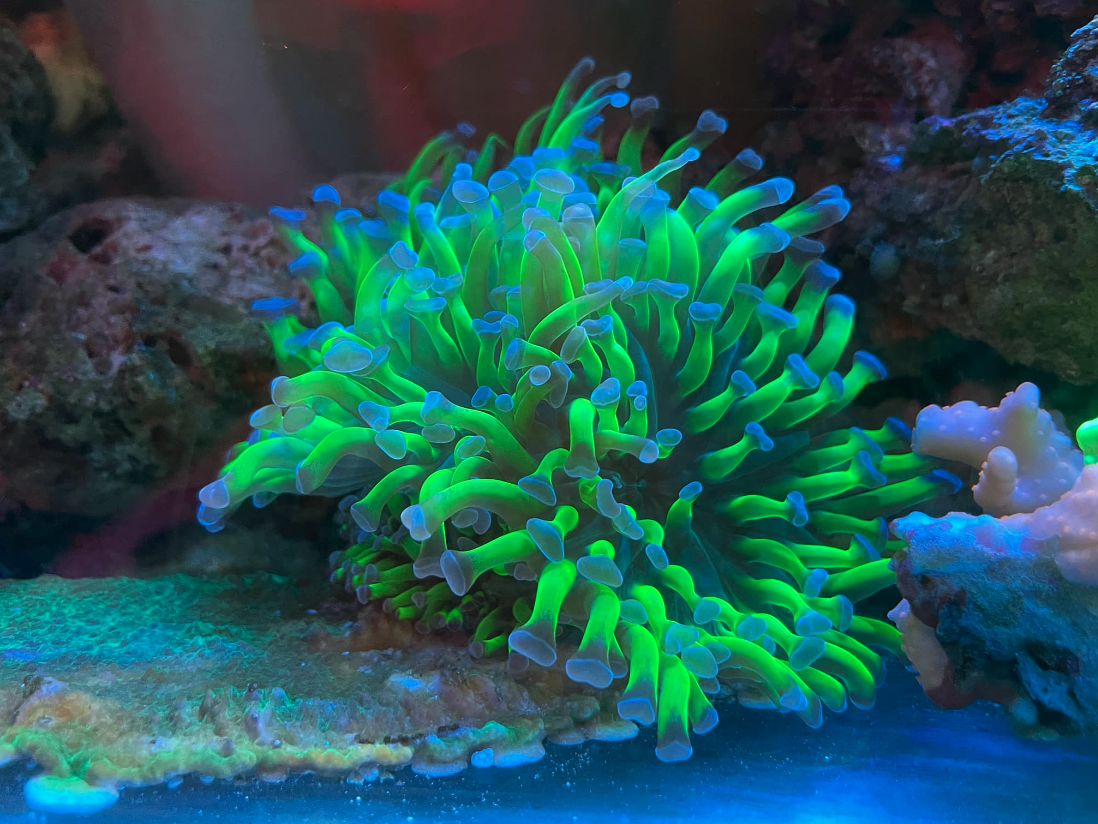
Originating around 650 million years ago and covering 1% of the world’s oceans, coral reefs support and provide a home for at least 25% of the planet’s marine life, making coral more important than many might realise. These plant-like animals are not to be underestimated, they harbour a very unique and fascinating relationship and play a vital role in sustaining life on Earth.
As one of the most critical species in our planet’s ecosystem, it’s more important than ever to understand what it is, how coral reefs are formed and everything in between. Let’s explore the different species of coral, what makes them unique and which ones we have here at Deep Sea World!
What is coral?
It’s a common misconception that coral is a plant, but in reality, it’s classified as a sea animal. Coral (Anthozoa) are a type of translucent invertebrate without a backbone belonging to the Cnidaria phylum, along with over 6,000 other sea creatures such as anemones and jellyfish.
Corals feed by reaching out their stinging tentacles to capture prey. But this isn’t the only way they get their nutrients. They primarily rely on algae that live within their cells, allowing them to use photosynthesis to convert energy into food.
What does coral look like?
Pinks, blues, oranges – coral appears to come in plenty of colours, shapes and sizes. But, strangely, they’re naturally translucent. Their colourful appearance comes from their extraordinary relationship with a type of algae called zooxanthellae. This symbiotic relationship benefits the algae and coral as both can get the nutrients they need to thrive.
Many coral species are well-known for their long, arm-like tentacles, which they use to feed on other creatures, such as zooplankton. But with over 6000 species of coral in the world, their similarities in size, colour and shape can vary hugely depending on factors like their habitat.
They can be split into two main groups: hard coral and soft coral. Hard corals are probably the ones you think of when you picture a coral reef, and these form hard exoskeletons made of calcium carbonate. Meanwhile, soft coral can’t produce the calcium carbonate to create reefs, which is why they often join other species’ reefs.
What are coral reefs?
Coral reefs can be found around the world, from the UK’s coastal areas to the shores of the Pacific. But how do singular coral species form a reef? This job falls to the hard coral.
Reef-building coral species will find a suitable habitat before depositing their calcium carbonate skeletons. Over time, these gradually build up to create a coral reef. They might look more like rocks from a distance, but on closer inspection, you can see their tiny polyps.
Coral reefs and singular coral species are responsible for around half of the world’s oxygen and can absorb carbon dioxide released from burning fossil fuels. However, one threat to coral reefs is coral bleaching, which could jeopardise their role in maintaining the planet’s balance. This is the process of coral rejecting the algae that give them their extraordinary colour.
Coral bleaching can occur when coral becomes stressed by things like rising temperatures, salinity and acidity changes, or other factors. If the stress triggers aren’t managed, it can lead to starvation and can kill off entire colonies of coral.
So, how do we prevent it and protect the coral in our waters? It’s simple, really – we protect the oceans. We can all do our bit to help, whether it’s recycling, saving energy, or being conscious of environmental impact when buying aquarium fish. By taking on board these actions, you can play a vital part in the conservation of all marine life, including coral.
Types of coral at Deep Sea World
Here at Deep Sea World, we’re drowning in coral species. In fact, our exhibit contain almost 20 different species! Below, you can find out their names and a little about each one.
- Acropora: Thriving in strong current areas, acropora is a small, stony coral belonging to the cnidaria phylum. Although they are commonly affected by coral bleaching, they’re also key to building many of the coral reefs in our oceans.
- Bush coral: Ranging in colour from orange to ivory, bush coral (Oculina varicosa) is often found in deep-water coral reefs between 50m and 150m below sea level.
- Button coral: This species (Cynarina lacrymalis), is best known for its round, doughnut-like shape and is one of the larger polyp stony corals.
- Cactus coral: The coral belonging to this species (Pavona cactus) are generally more peaceful, and because of this, they tend to live in habitats away from more aggressive types of coral.
- Cauliflower coral: Ranging from pink to brown in colour, cauliflower coral (Pocillopora meandrina) prefers to settle in shallow reef environments.
- Chalice coral sea: This large polyp stony coral (Echinophyllia aspera) is most often found in the Indo-Pacific region.
- Cornet coral: Also known as torch coral and pom-pom coral (Euphyllia glabrescens), this species is a type of hard coral.
- Duncan coral (whisker coral): Duncan or whisker coral (Duncanopsammia axifuga) thrives at depths of over 20m.
- Finger coral: Found in the Caribbean Sea (Porites compressa), finger coral tentacles can grow up to 5 metres in length.
- Frogspawn coral: With tentacles resembling a mass of frog eggs, frogspawn coral (Euphyllia divisa) is native to the shores of the Indo-Pacific islands.
- Hammerhead coral: Named after its hammer-like tentacles, hammerhead coral (Fimbriaphyllia ancora) is a hard coral species.
- Moon coral: Hardy and adaptable, moon coral species (Favia pallida) survive in warm, tropical waters off the coast of Africa, Japan and Australia.
- Mushroom coral: The Fungiidae family includes around 13 solitary and colonial species.
- Pineapple coral: Getting their name from their yellow, cream and brown colourings, pineapple coral (Dichocoenia stokesii) is a vibrant species you can spot easily.
- Star coral: Star coral (Montastraea) is a species belonging to the Merulinidae family and Orbicella genus.
- Spiny brain coral (large brain root coral): Named after their brain-like appearance, large brain root coral (Lobophyllia corymbose) is often grey or brown in appearance, making it much less colourful than other species.
- Table coral: Belonging to the Acroporidae family, table coral (Acropora clathrate) grows horizontally, so it has better access to light and food.
- Torch coral: Torch coral (Euphyllia glabrescens) have white-tipped tentacles which they can stretch out and sting other coral species with.
- Trumpet coral: Commonly referred to as the much-more-festive candy cane coral, trumpet coral (Caulastraea furcate) is a bright and colourful species you can’t miss!
We hope you’ve enjoyed our deep-sea dive into everything you should know about these exciting creatures. Head to our new Coral Tank to meet a wide range of coral species, including some of the exciting ones listed above!
Type
Sea animal: Translucent invertebrate belonging to the Cnidaria phylum
What do they eat?
Zooplankton, small fish & organic debris
Size
Individual coral species can grow to around 50cm
Water Type
Tropical & subtropical waters
Where are we?
Worldwide
